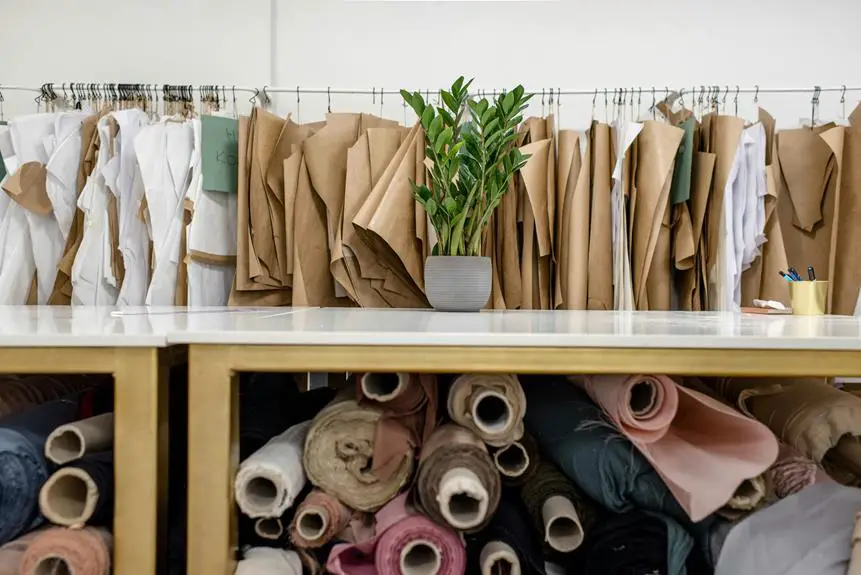You might've noticed a shift in consumer preferences towards fabrics that blend luxury with sustainability, and sateen is at the forefront of this trend. With innovations in production techniques and a growing emphasis on eco-friendly materials, the future of sateen could redefine its role in both fashion and home textiles. As the industry evolves, it's worth considering how these changes will impact design aesthetics and consumer choices. What emerging trends might influence how you perceive this fabric in your daily life?
Table of Contents
Evolution of Sateen Fabric
Sateen fabric has evolved significantly over the years, transforming from simple cotton weaves to luxurious textiles prized for their sheen and softness. Initially, you'd find sateen primarily made from cotton, showcasing a smooth finish ideal for sheets and pillowcases. This fabric gained popularity due to its ability to mimic silk's luxurious touch without the hefty price tag.
As technology advanced, manufacturers began experimenting with different fibers, blending cotton with synthetic materials like polyester. This innovation not only enhanced durability but also made sateen more affordable and accessible for everyday use. You'll notice that modern sateen exhibits a richer luster and a more refined drape, making it a preferred choice for everything from high-end bedding to stylish clothing.
The weaving technique itself has also progressed, allowing for tighter weaves that enhance both the fabric's appearance and feel. You might appreciate how the unique satin weave gives sateen its characteristic glossy surface, making it stand out in the textile market.
Today, sateen remains a versatile fabric, cherished for its elegant look and comfortable feel, capturing the essence of luxury while continuing to adapt to contemporary trends.
Sustainable Sateen Production
In an era where eco-consciousness is paramount, producers are increasingly embracing sustainable practices in sateen production.
You'll find that many manufacturers are turning to organic cotton, which uses fewer pesticides and chemicals. This shift not only reduces the impact on the environment but also promotes healthier working conditions for farmers.
Moreover, water conservation techniques are becoming standard. Techniques like rainwater harvesting and recycling water during the dyeing process minimize waste and lower the carbon footprint. You'll also notice that brands are prioritizing eco-friendly dyes that are less harmful to both the environment and consumers.
Recycling and upcycling are gaining traction as well. Some companies are taking discarded textiles and transforming them into new sateen fabrics, extending the life cycle of materials and reducing landfill waste.
Transparency in sourcing and production is another vital aspect; brands are increasingly sharing their sustainability efforts with consumers, allowing you to make informed choices.
Innovations in Textile Blends
As manufacturers explore new ways to enhance performance and comfort, innovative textile blends are revolutionizing the sateen market. These blends combine fibers like cotton, polyester, and modal to create fabrics that offer superior durability, breathability, and softness. You'll find that these advancements not only improve the feel of sateen but also its functionality.
One exciting trend is the integration of moisture-wicking technology into textile blends. By incorporating synthetic fibers with moisture management properties, manufacturers are ensuring that sateen remains comfortable in various climates. This is particularly beneficial for bedding and apparel, where comfort is paramount.
Another noteworthy innovation is the use of eco-friendly fibers. Blending organic cotton with recycled materials not only reduces environmental impact but also appeals to consumers who prioritize sustainability. These blends maintain the luxurious feel of traditional sateen while promoting responsible manufacturing practices.
As you explore the latest offerings in sateen, keep an eye out for these innovative blends. They're not just enhancing the textiles' performance but are also setting new standards for comfort and sustainability in the industry.
Consumer Trends and Preferences
Today's consumers are increasingly seeking sateen fabrics that not only offer luxury but also prioritize sustainability and comfort. You want materials that feel good against your skin while also aligning with your values. As awareness around environmental issues grows, you're drawn to brands that utilize eco-friendly practices and sustainable sourcing.
Here's a quick look at the key consumer preferences:
| Feature | Importance Level | Consumer Interest |
|---|---|---|
| Sustainability | High | 85% |
| Comfort | Medium | 75% |
| Luxury | High | 90% |
You might find yourself gravitating towards sateen options made from organic cotton or recycled fibers, which not only enhance your living space but also reduce your carbon footprint. Furthermore, the tactile experience of sateen—its smoothness and sheen—adds an element of sophistication to your wardrobe and home decor.
In this evolving market, you're likely to support brands that innovate while maintaining ethical practices. By choosing sateen, you're embracing a fabric that meets your aesthetic desires and aligns with your commitment to a better future.
Sateen in Home Furnishings
When you choose sateen for your home furnishings, you're adding a luxurious touch that feels soft and inviting.
It's essential to know how to care for this fabric to maintain its beauty and durability.
Let's explore some tips to keep your sateen looking its best while enjoying that premium feel.
Luxurious Touch and Feel
Sateen brings a silky, luxurious touch to home furnishings that elevates any space, making it feel more inviting and elegant. When you incorporate sateen into your décor, you instantly add a layer of softness and sophistication. The smooth, lustrous finish of sateen catches the light beautifully, creating a warm ambiance that enhances your living environment.
Imagine draping your sofa with sateen throw pillows or layering your bed with sateen sheets and comforters. The tactile experience is truly indulgent; you'll love the way it feels against your skin. Whether you're curling up with a book or hosting friends, sateen's luxurious touch elevates everyday moments into something special.
Sateen isn't just about looks; it also adds depth to your color palette. Available in rich hues and patterns, it brings a sense of luxury without overwhelming your space. You can effortlessly mix and match sateen pieces with other materials for a balanced, curated look.
Choosing sateen for your home furnishings reflects your taste for quality and comfort. So go ahead, embrace the luxurious feel of sateen, and transform your home into a sanctuary of style and warmth.
Care and Maintenance Tips
To keep your sateen home furnishings looking their best, proper care and maintenance are essential. Start by washing your sateen items in cold water with a gentle detergent to prevent fading and damage. Avoid using bleach, as it can ruin the fabric's luster. If you can, hand wash or use the delicate cycle on your washing machine.
When drying, skip the high heat settings. Instead, tumble dry on low or line dry to maintain the fabric's softness. If you notice wrinkles, use a low-heat iron, and always iron on the reverse side. This helps protect the sheen of the fabric.
For everyday upkeep, vacuum your sateen furnishings regularly to remove dust and dirt. If spills happen, blot the area immediately with a clean cloth—don't rub, as this can spread the stain. Use a mild fabric cleaner for tough stains, testing it on a hidden area first.
Lastly, store your sateen items in a cool, dry place, away from direct sunlight, to keep them vibrant. With these tips, your sateen home furnishings will stay luxurious and inviting for years to come.
Sateen in Fashion Industry
When you think about fashion, sateen's luxurious appeal often stands out in elegant designs.
Plus, with the rise of sustainable innovations, it's becoming a go-to choice for those who care about both style and the environment.
Let's explore how sateen is transforming the fashion landscape.
Sateen's Luxurious Appeal
There's something undeniably luxurious about sateen, making it a favorite choice for fashion designers aiming to elevate their collections. With its soft, smooth finish and subtle sheen, sateen exudes elegance that grabs attention and enhances any garment. You'll notice how it drapes beautifully, creating flattering silhouettes that complement your body shape.
In the world of fashion, sateen isn't just about look; it also feels fantastic against your skin. The fabric's breathable nature ensures comfort, whether you're wearing a stunning evening gown or a chic blouse. Designers love to play with sateen's versatility, using it for both casual and formal wear, allowing you to seamlessly transition from day to night.
You might find sateen in a variety of styles, from tailored jackets to flowing skirts. The fabric's ability to take on vibrant colors and intricate patterns adds to its appeal, making it a go-to for statement pieces.
Sustainable Sateen Innovations
Sustainable innovations in sateen are transforming the fashion industry, allowing designers to create stunning, eco-friendly garments that maintain the fabric's luxurious appeal.
You might be surprised to learn that many brands are now sourcing organic cotton or using recycled fibers to produce sateen. This shift not only reduces environmental impact but also enhances the quality of the fabric.
Additionally, you'll find that many companies are implementing water-saving techniques and utilizing natural dyes, further minimizing their ecological footprint. This commitment to sustainability is catching on, as consumers increasingly demand eco-friendly options in their wardrobes.
Brands are also experimenting with innovative weaving techniques to enhance sateen's durability while keeping its signature sheen. This means you can enjoy beautiful, long-lasting pieces without compromising on style or sustainability.
As you explore the latest collections, look out for those that prioritize ethical practices and sustainable materials. Supporting these innovations helps drive the fashion industry toward a more responsible future, ensuring that sateen remains a staple you can feel good about wearing.
Future Market Predictions
As the demand for innovative fabrics grows, the future market for sateen is poised to expand significantly.
You'll likely see an increase in its applications across various sectors, driven by consumer preferences for luxury and sustainability. Brands are expected to incorporate sateen into more product lines, which means you might find it in everything from home textiles to fashion.
Here are four key predictions for the sateen market:
- Increased Demand: Growing awareness of sustainable textiles will boost the demand for sateen made from organic and recycled materials.
- Technological Advancements: Innovations in weaving and finishing techniques will enhance sateen's performance, making it more appealing to consumers.
- Diverse Applications: Expect sateen to be utilized beyond traditional uses, including high-performance activewear and eco-friendly upholstery.
- Global Expansion: As markets in developing countries grow, you'll likely see sateen gaining popularity worldwide, diversifying its consumer base.
These developments indicate a bright future for sateen, and it's essential for you to stay updated on trends to make informed decisions in this evolving textile landscape.
Frequently Asked Questions
What Is the Origin of Sateen Fabric?
Sateen fabric originated in the Middle Ages, evolving from silk and cotton blends. You'll find it has a luxurious finish, thanks to its unique weaving technique, which creates a soft, smooth surface that feels beautiful against the skin.
How Does Sateen Compare to Other Cotton Fabrics?
Sateen's smoother, lustrous finish sets it apart from other cotton fabrics. It's softer and more luxurious, offering a drape that enhances elegance. You'll appreciate its durability and warmth, making it perfect for bedding and elegant garments.
Can Sateen Be Used for Activewear?
Yes, you can use sateen for activewear. Its smooth texture offers comfort, but keep in mind its breathability might not match other fabrics. Consider blends for better moisture-wicking properties to enhance performance during workouts.
What Are Common Care Instructions for Sateen Textiles?
When caring for sateen textiles, you should machine wash them in cold water, use a gentle cycle, and avoid bleach. Tumble dry on low heat, and iron on a low setting to maintain its sheen.
Is Sateen Fabric Hypoallergenic?
Sateen fabric isn't inherently hypoallergenic, but its smooth surface can reduce dust and allergens. If you're sensitive, look for sateen made from organic materials, which can help minimize potential reactions and provide a more comfortable experience.
- How Does Ring Spun Cotton Affect Garment Fit and Shape Retention? - August 13, 2024
- What Are the Challenges in Producing Ring Spun Cotton? - August 13, 2024
- Is Ring Spun Cotton Suitable for Plus-Size Clothing? - August 13, 2024




